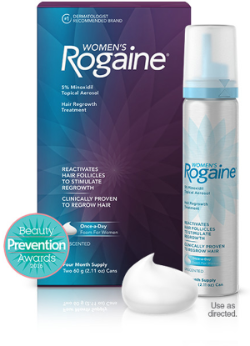As of 2014, women can finally purchase the Rogaine 5% foam product. You can buy Rogaine for women from Amazon as well as from your local pharmacy (Walmart, Walgreens and more) shelf.
Historically, women were advised to use the 2% topical Minoxidil product, even though many doctors were willing to prescribe the higher dosage men’s product to females. I prefer the 5% foam product much more than the terrible itch-inducing and dripping-onto-face topical liquid 2% product. For some reason, the latter is still on sale everywhere despite its bad reviews. As an aside, make sure to read my post on extra strength Minoxidil.
Does Rogaine Work for Women?
Most men do see some benefit from Rogaine. I am certain that Rogaine foam has helped my hair become thicker (and also acts as a mild gel as a side benefit). See my post on how Minoxidil works to grow hair. However, I am fairly sure that women will not benefit from this product as much as men, since the hair that grows from it is usually tiny.
Nevertheless, maintenance of existing hair in and of itself is a great benefit if you are one of the lucky female beneficiaries. In any event, women’s Rogaine foam is definitely worth adding to your arsenal of products, since it is very cheap and now finally available in the easy to use 5% foam version.
Trials Find 5% Minoxidil to be Superior to 2% Minoxidil for Women
Over the years, there have been a number of clinical trials that have found 5% Minoxidil (main ingredient in Rogaine) to be superior to 2% Minoxidil in women. Here is one from 2004.
Also make sure to read the results section of this Johnson and Johnson sponsored 1-year trial of 5% Minoxidil foam versus 2% topical Minoxidil in women. The trial ended in 2014.

For more information on this product, you can go through the official official women’s Rogaine website section.